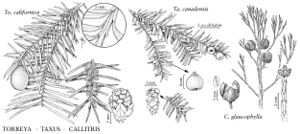Taxus
Sp. Pl. 2: 1040. 1753; Gen. Pl. ed. 5, 462, 1754.
| Taxon | Illustrator ⠉ | |
|---|---|---|
 | Torreya californica Taxus canadensis Callitris glaucophylla | John Myers John Myers John Myers |
Trees or shrubs dioecious or monoecious. Bark reddish-brown, scaly. Branches ascending to drooping; twigs irregularly alternate, green or yellow-green when young, reddish-brown in age. Leaves often appearing 2-ranked, flexible; stomates abaxial, in 2 broad, pale bands; apex soft-pointed, mucronate, not sharp to touch; resin canal absent. Pollen cones globose, yellowish, with 4–16 peltate sporophylls, each bearing 2–9 sporangia. Ovule 1. Seed maturing in 1 season, brown; aril scarlet to orange-scarlet, soft, mucilaginous, thick, cupshaped, open at apex, exposing hard seed-coat; albumen uniform. x = 12.
Distribution
Mainly north temperate regions
Discussion
The species of Taxus, discouragingly similar, are more geographically than morphologically separable; they were all treated by R. K. F. Pilger (1903) as subspecies of T. baccata Linnaeus. Detailed study of the genus (not neglecting the cultivated representatives), including extensive fieldwork, is much needed and long overdue.
The foliage, bark, and seeds—but not the fleshy red aril—of most Taxus species are toxic due to the presence of taxine (M. R. Cooper and A. W. Johnson 1984; J. M. Kingsbury 1964); this alkaloid, however, was not found in T. brevifolia (I. Jones and E. V. Lynn 1933). Two Eurasian species, T. baccata Linnaeus (English yew) and T. cuspidata Siebold & Zuccarini (Japanese yew), are best known and documented for toxicity. Cattle have been poisoned by T. canadensis planted in British Columbia, but toxicity of T. brevifolia has not been conclusively recorded (J. M. Kingsbury 1964). Although horses, cattle, and humans have been poisoned by ingesting yew leaves and seeds, the fresh foliage of T. canadensis is browsed by deer, and that of T. brevifolia by moose.
The only other yew native to the New World is Taxus globosa Schlechtendahl of Mexico and Honduras. The Old World T. baccata Linnaeus and T. cuspidata Siebold & Zuccarini—and T. × media Rehder, the alleged hybrid between these two—are common in cultivation in the flora area.
Although no extralimital species of Taxus is naturalized in North America, spontaneous, immature (sapling) exotic yews have been noted in a very few localities in the northeastern United States within the range of Taxus canadensis. Apparently originating from seeds dispersed (probably by birds) from cultivated yews, these plants differ from T. canadensis in having typically erect (rather than sprawling) stems. Immature volunteer yews are, with the use of macromorphological characters and with our present knowledge, probably unidentifiable to species.
Although species of Taxus are much cultivated in the Pacific Northwest, spontaneous yews have not been recorded there away from cultivated individuals, in the vicinity of which (or under which) they may reseed. Should such volunteers be found, the shape of their leaf epidermal cells as viewed in cross section—wider than tall (rather than taller than wide) or ± isodiametric—may be used to distinguish them from T. brevifolia.
Anatomical features of the leaves of yews, helpful in identification of the species, have been contributed by R. W. Spjut (unpublished data).
Species 6–10 (3 in the flora).
Selected References
Lower Taxa
Key
| 1 | Shrubs to 2 m, usually monoecious, low, sprawling, typically without a central stem; abaxial leaf surface mostly without cuticular papillae along stomatal bands; e North America (Manitoba to Newfoundland, south to Missouri, Kentucky, and Virginia). | Taxus canadensis |
| 1 | Shrubs or trees to 15(-25) m, dioecious, usually upright, typically with a central stem; abaxial leaf surface with cuticular papillae along stomatal bands; w North America or Florida. | > 2 |
| 2 | Shrubs or small trees to 15(-25) m, trunk diam. to 6(-12) dm; leaves yellow-green adaxially, epidermal cells as viewed in cross section of leaf mostly taller than wide; western North America (Alaska south to Montana and California). | Taxus brevifolia |
| 2 | Shrubs or small trees to 6(-10) m, trunk diam. to 3.8 dm; leaves dark green adaxially, epidermal cells as viewed in cross section of leaf wider than tall or ± isodiametric; northwestern Florida. | Taxus floridana |